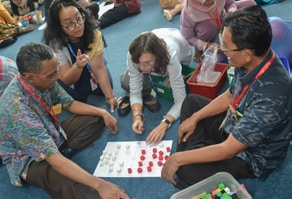According to ISC Research, there are currently 10,000 international schools around the world, enrolling over 5.3 million students. They are served by close to 500,000 faculty and administrators, both expatriate and local.1 With a workforce of that size, there’s a good chance that as an admissions professional, you lead or belong to a multicultural team.
At Jakarta Intercultural School, our admissions office mirrors the diversity of our student population, blending Indonesian, Filipino, Korean and TCK cultures. Cultural diversity adds a layer of complexity to teams by introducing different languages, communication styles, and conventions around time, giving and receiving feedback, and conflict resolution. Here are seven strategies that we have found helpful in building organizational capacity within our intercultural team to ensure consistent work standards and a consistent customer experience for the families that we serve.
1. Build relationships
 To beat Jakarta traffic, we often arrive half an hour before the office opens. This gives us time to gather in the kitchen and start our day with coffee and conversation. To an onlooker, it may look like idle chit-chat, but in reality we are building our cultural intelligence (CQ). Unguarded and authentic social engagement tunes us in to how our language, thought processes, customs, and gestures converge or diverge. This helps form a shared understanding of our individual contexts and builds trust.2 Shared lunch breaks, water cooler conversations, or after-office drinks accomplish the same goal.
To beat Jakarta traffic, we often arrive half an hour before the office opens. This gives us time to gather in the kitchen and start our day with coffee and conversation. To an onlooker, it may look like idle chit-chat, but in reality we are building our cultural intelligence (CQ). Unguarded and authentic social engagement tunes us in to how our language, thought processes, customs, and gestures converge or diverge. This helps form a shared understanding of our individual contexts and builds trust.2 Shared lunch breaks, water cooler conversations, or after-office drinks accomplish the same goal.
2. Recognize and adapt to cultural differences
In the JIS Admissions Office, our team members have a cultural tendency to be deferential. They can be reluctant to raise an opposing opinion. When seeking feedback on proposed training activities, we take a mindful approach, calling on the trust that we’ve built through social engagement. What works for our team is informal and indirect conversation. Yes, this requires an investment of time and patience, but the dividends are worth it. Through authentic conversation, we can tease out people’s thoughts and can be confident that the professional development we plan is consistent with the team’s needs and expectations.
3. Don’t always assume it’s a language issue
With team members who are non-native English communicators, we are careful not to assume that a gap in knowledge or skill is a product of language proficiency. As an example, a team member who recently took on the role of conducting tours requested language training in Business English because she lacked confidence in her communication skills. Together we unpacked her difficulties and concluded that it was not language that was her pitfall. Rather it was an inadequate understanding of the curriculum, which had changed considerably since she first joined the team. We arranged for her to attend parent community inquiry circles that focused on learning so that she could hear curriculum concepts explained to non-educators. We also had her shadow a student for a better understanding of how students learn. Lastly, we decided to extend her tour training, having her buddy-up with a more experienced team member. It would have been easier to enroll her in the training she requested but it would not have solved the underlying issue.
4. Consider professional development in the home language
Stuart Jay Raj, a cultural training consultant in Asia, suggests that conducting professional development in the participant’s home language improves engagement, retention, and results. When training is conducted in a foreign language or through an interpreter, participants tend to focus more on language competence than content; nuances become more difficult to articulate; and the fun factor disappears.3
 Though I am not able to run a full workshop in Indonesian, which is the language of the majority in our office, I have learned enough vocabulary to interject anecdotes and to understand general conversations. Even just saying a few words in Indonesian prompts reactions and energizes the room. It sparks conversations and engages people.
Though I am not able to run a full workshop in Indonesian, which is the language of the majority in our office, I have learned enough vocabulary to interject anecdotes and to understand general conversations. Even just saying a few words in Indonesian prompts reactions and energizes the room. It sparks conversations and engages people.
5. Share the right tools
Still on the subject of language, though our team members communicate fluently in English, there is a striking range of differences in vocabulary and syntax. Some colleagues may also be unaware of the subtext of certain English words and phrases. To avoid communication pitfalls, we develop scripts and templates for commonly used responses such as general inquiries and waitpools. Tech tools such as Grammarly help catch most grammatical and spelling errors.
6. Beat the Budget: Harness faculty expertise
In a 2015 survey by the Enrollment Management Association, 91% of Admissions Professionals were interested in professional development but only 59% had a budget allocated for it.4 With this constraint, admissions leaders need to get creative about providing training and upskilling staff. Consider offering workshops run by your faculty and administrators. Our Deputy has conducted a workshop on difficult conversations, and another on handling challenging customers. We have had a teacher run sessions on mindfulness and wellness at work. Most recently, we invited our learning support coordinator for a session on inclusion and contemporary language around learning support.

7. Host local mini-conferences or job-alikes
If your office team is strapped for professional development funds, chances are other international schools in your city are too. Consider hosting a mini-conference or job alike for your local network. Some of the recent events we hosted at JIS are an admissions and student support conference for admissions professionals and student support faculty, a mini-conference for Early Years admissions teams, and an admissions and marketing job-alike. These activities benefit both your team and your school. Your team will enjoy professional development and build a peer network, while the school gains visibility and forges goodwill with your local competitors.
A study by the Institute for Research on Intercultural Cooperation (IRIC) concluded that shared perceptions of daily practices should be considered the core of an organization’s culture.5 I see our role as leaders of intercultural admissions offices as weaving together our teams’ diverse backgrounds and values through engagement and professional development so that we can function cohesively to meet consistent standards and provide responsive, efficient, and exceptional service to families through the admissions cycle.
 About Jakarta Intercultural School
About Jakarta Intercultural School
Jakarta Intercultural School (formerly Jakarta International School) is the oldest and largest independent international school in Indonesia. It was founded in 1951 by the US, UK and Australian embassies. It is truly intercultural, with a student body of 2,350 students from over 70 countries, a faculty of 280 expatriates and over 800 host country staff. The community’s deep respect for their host country’s culture is reflected in the JIS mission: “Passionate, inquisitive and creative, learning in Indonesia to be best for the world.”
References
- Blog Posts - ISC Research. (2018, December 12). Retrieved from https://www.iscresearch.com/blog/default-post-blank-page/~board/news-from-theground/post/where-are-all-the-teachers-comingfrom-for-the-growing-international-schools-market
- Mosakowski, P. C. (2016, April 20). Cultural Intelligence. Retrieved from https://hbr.org/2004/10/cultural-intelligence
- Raj, S. (2015, November 30). Expat Managers – Why are you Training Your Local Staff? Retrieved from https://stujay.com/2015/11/30/expat-managerswhy-are-you-training-your-local-staff/
- The Enrollment Management Association International School Admission Industry Report (2015) https://enrollment.org/publications/specialreports/item/396-international-school-admissionindustry-report
- Hofstede, Geert, et al. Cultures and Organizations: Software of the Mind: Intercultural Cooperation and Its Importance for Survival. McGraw-Hill, 2010.


